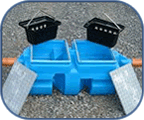| A major problem in the drainage system in dwelling houses restaurants, bars, etc. is the build up of grease and waste solids in the drainage system. While the grease is still warm it flows freely but once it cools it solidifies and eventually blocks the pipes. Therefore it is necessary to remove this grease at an early stage from the drainage system. This procedure also minimises pollution of the waterways. The solution is the JFC Grease Trap. The grease trap can be easily installed in new and existing waste water systems where 110mm piping is already being used. |
 |
| When the Waste Water enters the grease trap the grease rises to the top of the water level and eventually solidifies to form a hard layer at the surface. The heavier waste solids are deposited in the perforated filtering bucket which sits firmly at the bottom of the grease trap chamber. Its handle extends past the waste water level to prevent the user from coming into contact with the contents when emptying. |
 |
||||
| After the wastewater passes through the filtering bucket it then exists the grease trap through the outlet pipe and continues through the drainage system. The filtering bucket can be removed and the grease trap and trapped solids can be disposed of. |
 |
||||
 |
 |
| Stage 1 Inlet Chamber: The wastewater flows into the inlet chamber where the heavier waste solids are retained in the perforated filtering bucket. At this stage some grease may solidify and rise to the top to form a layer of sludge. There is a baffle to retain any un-trapped solids in this chamber. |
Stage 2 Settlement Chamber: The wastewater flows under gravity from the inlet chamber into this chamber. It acts as a buffer zone where the wastewater will circulate by natural currents to cool the remaining grease. Then the wastewater flows forward into the outlet chamber. |
Stage 3 Outlet Chamber: This chamber collects the remaining grease from the waste water and retains it in the perforated filtering bucket. The wastewater flows under gravity through the outlet. There is a baffle to retain any un-trapped solids in this chamber. |






